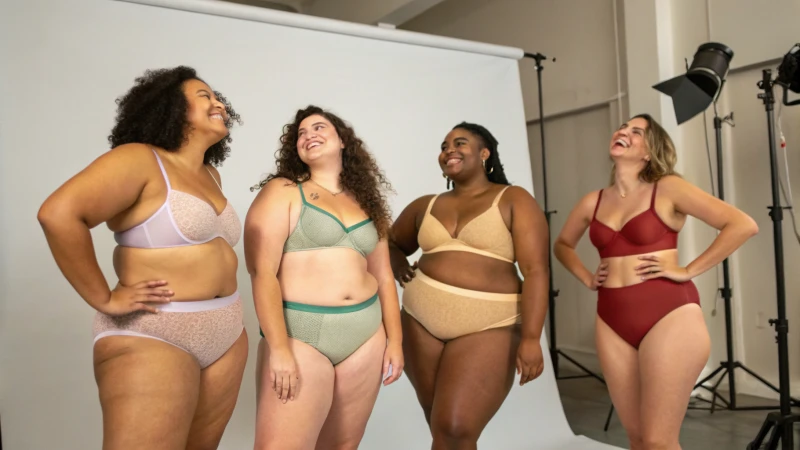
Have you ever dreamed of creating something that makes people feel comfortable and confident? Launching your own underwear brand might be the perfect way to turn that dream into reality.
To start a successful underwear business, begin by conducting thorough market research to understand your target audience and competitors. Develop a clear brand identity, select high-quality materials, establish reliable supplier connections, and implement effective marketing strategies to attract and retain customers.
While this overview sets the foundation for your venture, each step involves its own complexities and requires detailed planning. In the following sections, we’ll delve deeper into practical strategies and insider tips that can give you an edge in this competitive industry.
Market research is optional for starting an underwear business.False
Thorough market research is crucial for understanding target audience and competitors.
What Market Research is Essential Before Launching?
Before launching your underwear brand, conducting thorough market research is crucial to understanding your audience and the competitive landscape.
Essential market research for launching an underwear brand includes analyzing consumer preferences, identifying key competitors, and understanding current industry trends. Utilize surveys, focus groups, and online tools to gather insights that will inform your product development and marketing strategies.

Understanding Your Target Audience
The first step in market research is to thoroughly understand who your target customers are. Are they young professionals looking for comfort, or fashion-forward individuals seeking trendy designs? Creating customer personas can help you tailor your products and marketing efforts effectively.
Conduct Surveys and Interviews: Leverage tools like Google Forms or SurveyMonkey to gather data directly from potential customers. Consider asking questions about their preferences in fabric, fit, style, and purchasing habits.
Utilize Social Media Insights: Platforms like Instagram and Facebook offer insights into demographics and engagement patterns. Use these tools to observe how your target audience interacts with current brands and trends.
Analyzing Competitors
Competitor analysis is a critical component of market research. Identifying who your main competitors are and what they offer helps you carve out your niche.
| Competitor | Key Strengths | Weaknesses |
|---|---|---|
| Brand A | High-quality materials, sustainable practices | Higher price point |
| Brand B | Trendy designs, strong social media presence | Limited size range |
| Brand C | Affordable pricing, broad distribution | Inconsistent quality |
Explore their marketing strategies, customer reviews, and overall market position to find gaps you can fill.
Identifying Industry Trends
Keeping up with current fashion trends1 in the underwear industry is vital. This involves understanding shifts in consumer demand, such as the growing interest in sustainable materials or inclusive sizing.
Use Online Tools: Resources like Google Trends can provide insights into what consumers are currently interested in. Additionally, attending trade shows or subscribing to industry publications can keep you informed about upcoming trends.
Focus Groups: Organize focus groups to get direct feedback on prototypes or concepts. This qualitative data can reveal subtle consumer needs not captured in surveys.
Leveraging Digital Tools
Digital tools can streamline your research process significantly. Platforms like SEMrush2 offer comprehensive data on market trends and competitor analysis.
By combining qualitative and quantitative data, you'll have a robust foundation to make informed decisions about your brand's direction and ensure a successful launch.
Competitor analysis is optional for market research.False
Competitor analysis is critical to understand strengths and gaps.
Surveys are useful for understanding consumer preferences.True
Surveys provide direct insights into customer needs and habits.
How Do You Develop a Unique Brand Identity?
Creating a unique brand identity is crucial for distinguishing your underwear brand in a crowded market.
To develop a unique brand identity, start by defining your brand's core values and mission. Understand your target audience deeply and create a visual style that resonates with them. Consistent messaging across all channels solidifies your brand's presence and fosters customer loyalty.

Understanding Your Brand's Core Values
The first step in developing a unique brand identity is to pinpoint your core values. These values act as the guiding principles for your brand. Ask yourself questions like: What does my brand stand for? What unique qualities set it apart from competitors? These answers will shape every aspect of your branding, from design to marketing.
For instance, if sustainability is a core value, this should be reflected in everything from the materials you choose to your packaging practices3. This consistency not only builds credibility but also attracts customers who share these values.
Knowing Your Target Audience
A deep understanding of your target audience is crucial. Conduct surveys, focus groups, and analyze market data to gather insights into your potential customers' preferences and buying behavior. This information allows you to tailor your brand message and aesthetic to appeal directly to your audience.
By creating customer personas, you can visualize typical customer traits and habits, which can inform your design choices4 and marketing strategies.
Crafting a Visual Style
Visual elements such as logos, color schemes, and typography are fundamental components of your brand identity. Consider creating a style guide that outlines these elements to ensure consistency across all platforms. This consistency helps in building brand recognition.
For example, a minimalist logo with neutral colors might appeal to an audience looking for modern, sleek designs. A more vibrant palette could attract a younger demographic seeking fun and energetic styles.
Maintaining Consistent Messaging
Your brand's voice should be consistent in all communications, whether it's on social media, emails, or packaging. This consistency strengthens your brand's identity and makes it easily recognizable.
Develop a content strategy that outlines the tone, style, and key messages you want to convey. Whether your tone is professional, casual, or quirky, maintaining it across all touchpoints enhances customer trust and loyalty.
Building an Emotional Connection
Brands that evoke emotions tend to resonate more with customers. Use storytelling to share your brand's journey or highlight customer experiences with your products. This emotional connection can differentiate your brand from competitors and foster long-term loyalty.
Consider hosting events or creating content that engages customers on a personal level. By investing in community-building activities5, you not only promote your brand but also strengthen customer relationships.
Core values are not essential for brand identity.False
Core values guide branding decisions, shaping identity and customer appeal.
Consistent messaging fosters customer loyalty.True
Consistency in messaging builds trust and strengthens brand recognition.
What Are the Best Sourcing Strategies for Quality Materials?
Choosing the right materials can make or break your underwear brand. Discover effective sourcing strategies now!
To source quality materials for your underwear brand, prioritize building relationships with reputable suppliers, visit trade shows, request samples, and conduct quality inspections. Consider factors like sustainability, cost, and supplier reliability to ensure consistent material quality.

Building Relationships with Reliable Suppliers
One of the most effective sourcing strategies is establishing strong relationships with reliable suppliers. This involves not only selecting suppliers known for quality but also fostering ongoing communication and collaboration. Frequent visits to suppliers' facilities can provide insights into their production processes, helping you assess their ability to meet your standards consistently.
For instance, partnering with a supplier who specializes in eco-friendly materials can align with your brand’s sustainability goals. Look for suppliers who have certifications for sustainable practices and ensure they adhere to industry standards.
Attending Trade Shows and Industry Events
Trade shows are invaluable for discovering new materials and networking with potential suppliers. These events often showcase the latest innovations in textiles, providing a chance to see and feel the quality of materials firsthand.
At these events, you can compare different materials side by side, negotiate prices, and even establish connections that could lead to more favorable terms. For example, attending an international textile fair might introduce you to emerging trends and technologies in material production.
Requesting Samples and Conducting Inspections
Before committing to a bulk purchase, always request samples from potential suppliers. This allows you to evaluate the material's quality, texture, durability, and overall feel. It's essential to conduct thorough inspections of these samples to ensure they meet your brand’s requirements.
Implementing a quality control checklist during sample inspection can help maintain high standards. Consider factors like colorfastness, stretchability, and softness when assessing underwear materials.
Evaluating Sustainability and Cost-Effectiveness
Balancing sustainability with cost-effectiveness is crucial in sourcing materials. While sustainable options might be more expensive initially, they can offer long-term benefits such as brand differentiation and customer loyalty.
Create a table comparing potential materials based on key criteria:
| Material Type | Cost per Unit | Sustainability Rating | Supplier Reliability |
|---|---|---|---|
| Organic Cotton | $5 | High | Reliable |
| Recycled Polyester | $4 | Medium | Moderately Reliable |
| Bamboo Fabric | $6 | Very High | Highly Reliable |
When evaluating options like organic cotton6, consider both the environmental impact and the potential premium you can charge for eco-friendly products.
Importance of Supplier Reliability
Finally, a supplier’s reliability in terms of timely deliveries and consistent quality cannot be overstated. It’s often beneficial to maintain relationships with multiple suppliers to mitigate risks associated with supply chain disruptions.
By implementing these strategies, you can ensure that your underwear brand stands out for its quality materials, aligning with both your brand values and customer expectations.
Building supplier relationships ensures consistent material quality.True
Strong supplier relationships help ensure consistent quality through collaboration.
Trade shows offer limited opportunities for sourcing new materials.False
Trade shows provide extensive opportunities to discover and compare materials.
How Can You Effectively Market Your Underwear Brand?
Unlock the secrets to capturing attention and loyalty in the competitive underwear market.
Effectively marketing your underwear brand involves creating a strong online presence, leveraging social media, collaborating with influencers, and utilizing targeted advertising. Engage your audience with compelling storytelling, unique selling propositions, and personalized customer experiences to stand out in the crowded market.

Building a Strong Online Presence
In today’s digital age, establishing an engaging online presence is paramount. Begin by creating a visually appealing website that reflects your brand identity. Make sure your website is user-friendly and mobile-responsive7, as a significant portion of traffic will come from mobile users. Utilize high-quality images and videos to showcase your products effectively.
Leveraging Social Media
Social media platforms like Instagram and TikTok are ideal for marketing underwear brands due to their visual nature. Regularly post engaging content that resonates with your target audience. Consider using interactive content such as polls and stories8 to increase engagement. Implement hashtags strategically to expand your reach and attract new followers.
Collaborating with Influencers
Partnering with influencers can significantly boost your brand visibility. Choose influencers whose audience aligns with your target market. Offer them exclusive products or limited-time discounts in exchange for authentic reviews and features on their channels. This collaboration can lead to increased trust and credibility among potential customers.
Utilizing Targeted Advertising
Harness the power of targeted advertising through platforms like Facebook Ads and Google Ads. These tools allow you to focus on specific demographics, interests, and behaviors, ensuring your advertisements reach the right people. A/B testing different ad creatives can help identify what resonates best with your audience, leading to improved conversion rates.
Engaging with Compelling Storytelling
Storytelling is a powerful tool in marketing. Share the journey behind your brand, highlight the ethical sourcing of materials, or showcase the artisans crafting each piece. By connecting emotionally with your audience, you create a loyal customer base more likely to advocate for your brand.
Providing Personalized Customer Experiences
Personalization can dramatically improve customer satisfaction and retention. Implement AI-driven product recommendations9 based on browsing history or previous purchases. Offer custom fitting advice or style guides tailored to individual preferences. Personal touches can make your brand memorable and encourage repeat business.
Social media is not effective for underwear marketing.False
Social media platforms are ideal due to their visual nature.
Influencer collaboration increases brand visibility.True
Partnering with influencers boosts visibility and credibility.
Conclusion
By strategically planning each step from research to marketing, you can lay a strong foundation for your underwear business. Embrace feedback, adapt to trends, and continuously refine your strategies to thrive in the lingerie market.
Stay updated with the latest consumer interests and market shifts.: The Hottest Underwear Trends Every Woman Should Know : 1. Eco-friendly fabrics 2: High-waisted revival 3: peek-a-boo lace 4: Seamless magic ... ↩
Discover how SEMrush can enhance your market research efficiency.: Learn to do market research, the process of gathering information about your target market and customers. ↩
Explore sustainable packaging practices to align with eco-friendly values.: H & M · By 2025 H&M will reduce the packaging across its value chain by 25% and have all its packaging designed to be reusable or recyclable. · By ... ↩
Discover how customer personas influence design choices effectively.: Learn how to create and use customer personas to understand your target customers and position your fashion brand in a competitive market. ↩
Learn about community-building activities that enhance customer engagement.: Cross-Functional Collaboration · Creative Workshops · Role Rotation · Feedback Sessions · Team Retreats · Skill Sharing · Celebrating Milestones. ↩
Discover the environmental benefits of using organic cotton in your products.: This soft, lightweight fabric is naturally breathable, which means that your organic cotton clothes and bedding will keep you nice and cool in ... ↩
Learn why mobile responsiveness is crucial for user experience and sales.: Mobile-responsive designs provide easier navigation, faster loading times, and clear call-to-actions that are easy to click on smaller screens. It's not always ... ↩
Discover how interaction on social media enhances brand engagement.: From AI-driven personalization to community-centric features, We will dive into the elements that drive user satisfaction and engagement. ↩
Understand how AI can personalize shopping experiences effectively.: This saves money, enhances efficiency, and reduces environmental impact by minimizing waste and optimizing inventory management. Retail and e- ... ↩






